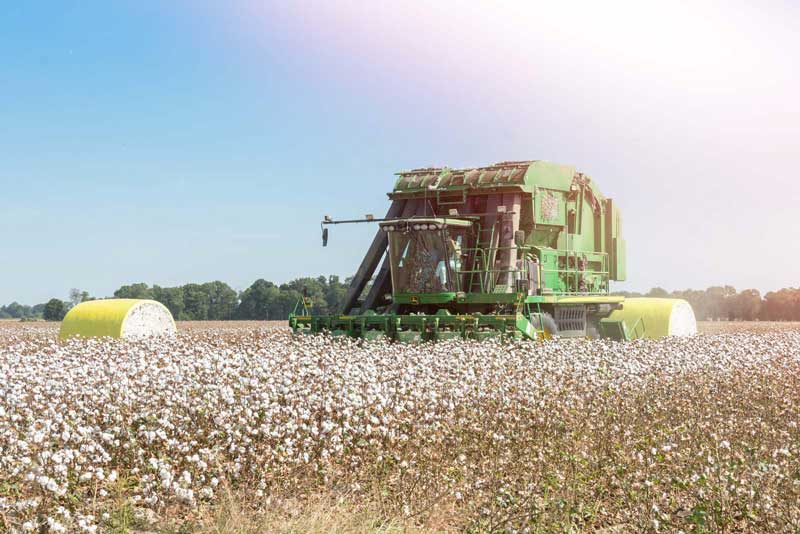Cotton, often called “white gold,” is one of the world’s most widely grown crops, playing a crucial role in the global textile industry. However, conventional cotton farming and harvesting methods have been associated with various environmental and social concerns. From excessive water usage to soil degradation and pesticide contamination, the impact of cotton cultivation can be significant. In recent years, there has been a growing emphasis on sustainable practices in agriculture, including cotton farming. In this blog, we dive into the challenges of harvesting cotton sustainably while balancing yield and minimizing environmental impact, focusing on the role of modern technology, particularly the cotton picker machine.
The Evolution of Cotton Harvesting
Traditionally, cotton harvesting was a labor-intensive process, relying on handpicking by workers in the fields. This method was not only time-consuming but also required a large workforce, often leading to exploitation and poor working conditions, particularly in regions where cotton is a major cash crop. As the demand for cotton increased with industrialization, there arose a need for more efficient harvesting methods.
The invention of the mechanical cotton picker revolutionized the industry. Patented in the early 20th century, these machines mechanized the process of harvesting cotton, significantly reducing the need for manual labor. The first cotton picker machines were large and cumbersome, but over time, technological advancements led to the development of more efficient and compact models.
Modern cotton picker machines are equipped with advanced features such as automated harvesting systems, GPS navigation, and onboard computers for real-time data collection. These innovations have not only improved the efficiency of cotton harvesting but also paved the way for more sustainable practices.
Challenges of Conventional Cotton Harvesting
While mechanical cotton picker machines have made harvesting more efficient, conventional cotton farming still poses several challenges in terms of sustainability and environmental impact.
- Soil Degradation: Conventional cotton farming practices, such as monocropping and intensive tillage, can lead to soil erosion and degradation. This results in soil fertility and biodiversity loss, posing long-term threats to agricultural productivity.
- Water Usage: Cotton is a water-intensive crop that requires significant amounts of irrigation to grow. In regions where water resources are scarce, excessive irrigation for cotton farming can deplete aquifers and exacerbate water scarcity issues.
- Pesticide Pollution: Cotton cultivation relies heavily on pesticides to control pests and diseases. However, the indiscriminate use of pesticides can pollute soil, water, and air, harming both the environment and human health.
- Energy Consumption: The production and operation of cotton picker machines, as well as other machinery used in conventional cotton farming, contribute to energy consumption and greenhouse gas emissions, further exacerbating climate change.
Sustainable Solutions in Cotton Harvesting
Various approaches and technologies have been developed to address these challenges and promote more sustainable cotton harvesting practices.
- Precision Agriculture: Precision agriculture techniques, such as GPS-guided machinery and remote sensing technology, enable farmers to optimize inputs such as water, fertilizers, and pesticides, reducing waste and minimizing environmental impact.
- Conservation Tillage: Adopting conservation tillage practices, such as minimum tillage or no-till farming, helps to preserve soil structure and minimize erosion, thus improving soil health and reducing environmental degradation.
- Organic Farming: Transitioning to organic cotton farming eliminates the use of synthetic pesticides and fertilizers, reducing the environmental impact and promoting biodiversity. Organic cotton farming also emphasizes soil conservation and natural pest management practices.
- Biotechnology: Advances in biotechnology have led to the development of genetically modified (GM) cotton varieties with pest resistance and drought tolerance traits, reducing the need for chemical inputs and enhancing sustainability.
Role of Cotton Picker Machines in Sustainable Harvesting
Cotton picker machines play a crucial role in sustainable cotton harvesting by improving efficiency, reducing labor dependency, and minimizing environmental impact.
- Efficiency: Modern cotton picker machines can harvest large quantities of cotton in a relatively short time, increasing efficiency and productivity compared to manual labor. This enables farmers to meet the market’s demands while reducing the need for additional resources.
- Labor Savings: By automating the harvesting process, cotton picker machines eliminate the need for manual labor, reducing labor costs and dependency. This is particularly beneficial in regions where labor shortages or labor exploitation are prevalent, improving working conditions for farm workers.
- Reduced Environmental Impact: Cotton picker machines are designed to minimize soil compaction and disturbance during harvesting, preserving soil structure and reducing erosion. Additionally, using precision agriculture technologies in conjunction with cotton picker machines helps optimize inputs such as water and pesticides, minimizing waste and pollution.
- Innovation and Adaptation: Continued innovation in cotton picker machine technology, such as the development of self-driving and robotic harvesters, holds promise for further improving efficiency and sustainability in cotton harvesting. These advancements enable farmers to adapt to changing environmental conditions and market demands more effectively.
Conclusion
Harvesting cotton sustainably requires a multifaceted approach that balances yield, efficiency, and environmental impact. While conventional cotton farming practices have historically posed challenges in terms of sustainability, modern technologies, and innovations, particularly in cotton picker machines, offer promising solutions.
By embracing sustainable practices such as precision agriculture, conservation tillage, organic farming, and biotechnology, coupled with the efficient use of cotton picker machines, farmers can minimize their environmental footprint while maintaining productivity and profitability. Moving forward, continued investment in research and development and policy support for sustainable agriculture will be essential in ensuring a more sustainable future for the cotton industry.

